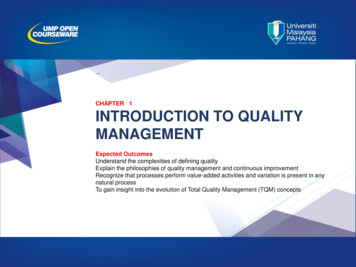
Transcription
CHAPTER 1INTRODUCTION TO QUALITYMANAGEMENTExpected OutcomesUnderstand the complexities of defining qualityExplain the philosophies of quality management and continuous improvementRecognize that processes perform value-added activities and variation is present in anynatural processTo gain insight into the evolution of Total Quality Management (TQM) concepts
Chapter Outline Introduction Defining Quality Quality aspect Dimensions of Quality Three sphere of Quality Evolution of Quality TQM Framework Obstacles Benefits of TQM Gurus of Quality / TQM
What is Quality?
Quality Definition Definition of quality are: Meet the specification Satisfying customer need Fitness for purpose* Quality of a product or services is its ability to satisfy the needsand expectations of the customer
Quality DefinitionSome of the definitions of the term ‘Quality', provided byquality gurus are as follows: Quality is fitness for use (JURAN) Quality is conformance to requirements (CROSBY) The efficient production of the quality that themarket expects (DEMING) Quality is what the customer says, it is(FEIGENBAUM)
Quality Definition Quality is the loss that a product costs to the societyafter being shipped to the customer (TAGUCHI) The totality of features and characteristics of a productor services that bear on its ability to satisfy stated orimplied needs of the customers (ASQC) A quality system is the agreed on company wide and plantwide operating work structure, documented in effective,integrated, technical and managerial procedures for guidingthe co-coordinated actions of people, the machines, or theinformation of company in the best and most practical waysto assume customer quality satisfaction and economicalcosts of quality. (FEIGENBAUM)
Modern Quality Definition “Quality is inversely proportional to variability”Quality 1/Variability This definition acknowledges that variability ispresent in all processes. Sources of variabilityinclude:1. Process variability includes raw materials, machines,operators and environmental conditions2. Measurement variability3. Sampling variability Given that quality is inversely proportional tovariability, so it means by improving quality, we willreducing variability.
Quality Can be Quantified asQ P/Ewhere Q quality;P performanceE expectations If Q 1.0 : then the customer has a good feelingabout the product/service. P and E are determined based on perception. P is determined by the organization and E by thecustomers. Customer expectations are becoming moredemanding from day-to-day.
Essence of Quality
Where does QUALITY apply?
Aspect of Quality
Aspect of Quality1) Quality of design (consumer’s perspective)- determine the Q characteristics of products that suited to theneeds & wants of a market at a given cost.2) Quality of conformance (manufacturer’s perspective)- ability of firms and it’s supplier to produce the product withpredictable degree of uniformity & dependability as in Q ofdesign.3) Quality of performance- studies focus on determining how the Q characteristicsidentified in Q of design & improved and innovated in Q ofconformance
Product Quality Dimensions*Source: Garvin, 1988
Product Quality Dimensions These 9 dimensions are independent, therefore a productmay be excellent in one dimension and average or poor inanother. Very few products excel in all 9 dimensions. Example: In 1970s, the Japanese were cited for high ONFORMANCE and AESTHETICS. These dimensions been translated into the requirements forthe development of a new product or the improvement of anexisting one.
Service Quality Dimensions*Source: Parasuraman et.al, 1988
Three Sphere of Quality
Three Sphere of Quality
QA vs QC
Activities of QA, QC and QM
Total Quality Management Total Quality Management (TQM) is an enhancement tothe traditional way of doing business. It’s a proven technique to guarantee survival in worldclass competition TQM integrates fundamental management techniques,existing improvement efforts and technical tools under adisciplined approach It is the application of quantitative methods and humanresources to improve all the processes within anorganization and exceed customer needs now and in thefuture.
New and Old Culture
New and Old Culture
Obstacles of TQM Lack of Management Commitment Inability to Change Organizational Culture Improper Planning Lack of Continuous Training and Education Incompatible Organizational Structure and IsolatedIndividuals and Departments Ineffective Measurement Techniques and Lack ofAccess to Data and Results Paying Inadequate Attention to Internal and ExternalCustomers Inadequate Use of Empowerment and Teamwork Failure to Continually Improve
Benefits of TQMThe benefits of TQM are improved:QualityEmployee ParticipationTeamworkWorking RelationshipsCustomer SatisfactionEmployee Market Share
Gurus of TQM
Total Quality Management Total Quality Management (TQM) is an enhancement to the traditional way of doing business. It’sa proven technique to guarantee survival in world-class competition TQM integrates fundamental management techniques, existing improvement











